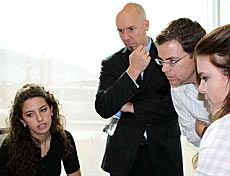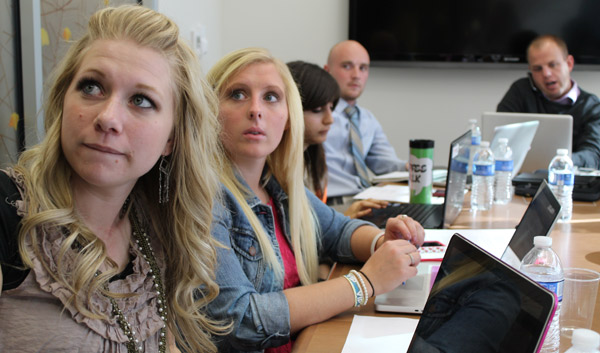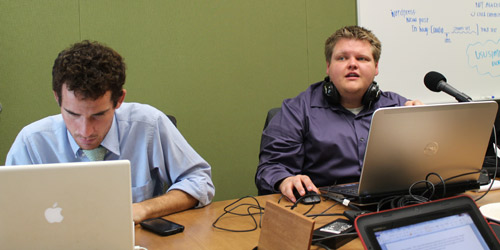Journalism and PR students scramble, learn in crisis simulation
November 9th, 2012 Posted in OpinionBy Kristen Munson
Photos by Danielle Manley
Special from Utah State Today
LOGAN—Six minutes into a crisis communication simulation conducted by the Department of Journalism and Communication at Utah State University, student participants learn that the mayor’s son is dead, his body found at the local high school. Rumors of a zombie cow disease are spreading.
That’s how it continued for nearly seven more hours of news twists, red herrings and breaking stories.

JCOM Professor Matthew LaPlante and students work through responses to the day-long crisis simulation exercise. Danielle Manley photo.
“You see how they’re crammed into rooms?” said journalism professor Matthew LaPlante, pointing to an office where 10 students sat elbow-to-elbow tapping on laptops. “That’s intentional. I want them to be tired, hot and sweaty at the end. There is nothing better than this, there is nothing worse.”
The simulation involved more than 50 JCOM students and volunteers from across the university, including the USU Police Department, the Department of Animal, Dairy & Veterinary Sciences, the Quinney College of Natural Resources and the Jon M. Huntsman School of Business.
Students were organized into teams of television, radio, print and digital media reporters—working for organizations like KAGG-TV and “The Logan Ledger”—a public relations agency, and a regional agricultural control board. Each group was set up with a fake Twitter handle, website and email address. They were given “loose marching orders,” to respond and cover the events of the day with professionalism, LaPlante said.
The idea for the simulation developed out of a counterterrorism exercise run by the University of Utah’s law school that trains students to make critical decisions involving legal, ethical and moral dilemma while under stress. LaPlante’s first exposure to the simulation came while covering it as a national security reporter for The Salt Lake Tribune. During a follow-up conversation with the professor who ran the event, LaPlante suggested that he include a press corps to participate in future simulations so law students could learn how to operate when reporters are firing questions at them.

Members of the crisis public relations team work to develop a unified message for their “client” during the simulated cow illness. Danielle Manley photo
“What he needed was a measure to assess his students,” he said.
LaPlante returned for several years as an adviser for the law school simulation. Last year, he took several Utah State students to participate, including Kara Rindlisbacher, a public relations major.
“I made mistakes, and I learned as I watched others make mistakes,” she said. “I kept thinking this is the greatest educational experience I have ever had and I’ve been at Utah State four years. There is something wrong.”
Rindlisbacher pressed LaPlante to institute a similar exercise at Utah State. He gave her his blessing to move forward with planning. She texted Cari Forsgren, a rangeland management student, asking her how one could theoretically kill off a large portion of the cattle in Cache Valley.
“Give me 10 minutes,” Forsgren responded.
The two spent three months writing the script, wrangling volunteers and coordinating logistics. It unfolded with only minor snafus, such as students reporting real news stories in conjunction with the fictional storylines. As in the real world, 24 minutes into the simulation the first signs of frustration appeared. Students from the local paper paced the hallways, waiting for unknown sources to return their calls. Two floors down the public relations office fielded calls from demanding clients.
“This begins as a ‘normal’ day at the office, but then the phone starts ringing,” said PR professor Steve Reiher outside a cramped conference room. “These are little crises that mushroom. None of [the students] have been in anything like it. I think what they learn is what to prioritize.
“One of the things we’ve been talking about in the department is having more crisis management because that is something many PR students will face.”
And crises never seem to hit when you’re ready for them. LaPlante played the role of newspaper publisher, mayor and simulation moderator — whatever was needed at the time. During a visit to the PR office, he admonished the team for writing a press release for the mayor.
“Is he even a client?” he asked. “Is he paying us or are we doing this pro bono? I feel very sorry for the mayor but if we are doing this pro bono I want to know.”
Down the hall, broadcast students calmly conduct interviews and package stories to stream stories over YouTube. The team is led by Troy Hunt, a JCOM professor at USU Eastern who drove from Price with one of his students the night before to participate.
“It’s a good opportunity for students to have real-world assignments, to have deadline pressure,” he said. “I can give them a story and say it’s due next week, but that’s not real world.”

Radio newscasters Kevin Meacham, left, and Kelton Wells report on the developing cow crisis during the emergency news drill. Danielle Manley photo
JCOM student Daniel Whitney Smith agrees. Last year, at the University of Utah’s simulation, he was a member of the press corps at the law school’s exercise, and the experience was jarring.
“It was really hard to multitask,” he said. “And I thought I was a good at multitasking.”
At the Utah State simulation, Smith played a shadow character — one of the few participants who knew the script ahead of time and operated as sources for the various storylines. He played a Hollywood executive and a bully who teased the mayor’s son.
At least, that’s who he was before lunch. Smith, a writer for the Hard News Cafe, left the exercise to go cover the lieutenant governor debate on campus. He would return afterward to pick up his roles, and perhaps a few more.
“You can take all the journalism classes you want, but unless you experience drinking from the fire hose like this — where you have three phones ringing, and you’re taking to someone and trying to keep names straight while writing a story — you don’t know,” he said.
At the end of the day, the student journalists had written hundreds of tweets, scores of stories for print and broadcast, and a TV news broadcast that aired on “KAGG-TV,” created in hours instead of the usual days that TV news students normally put into producing the usual weekly Aggie TV newscast.
For professionals like Capt. Steven Milne of the USU Police Department, the exercise was an opportunity to review official policies and practice what to do in an emergency. He has received media relations training at the FBI National Academy and serves as the department’s liaison to the press. He believes the USU simulation is a valuable tool for learning.
“In law enforcement we call it scenario-based training,” Milne said. “It was a good experience because it made you think ‘what can I release?’ If [JCOM] does this again I would like to bring some of sergeants up so they get experience taking calls from the media. You can read all the books you want, but [in a crisis] all things get thrown out the window.”
TP
Tags: Capt. Steven Milne, crisis simulation, dying cows, JCOM, Matthew LaPlante

Sorry, comments for this entry are closed at this time.